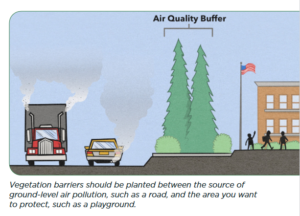April 29, 2022
Can plants help fight air pollution near Chicago schools?
Schools near busy traffic corridors are exposed to unhealthy levels of air pollution. Vegetative buffers can help protect students, teachers, and staff.
ELPC has teamed up with a new coalition to identify over two dozen Chicago schools that could benefit from an innovative new approach to air quality protection. These schools face high traffic pollution risks, and the most vulnerable among them have over 200,000 vehicles passing by every day. Many have playgrounds, bus stops, or other outdoor areas directly adjacent to highways. Exposure is not limited to time spent outside — these schools often lack adequate filtration systems, allowing pollutants to circulate in the air that students breathe throughout the school day.
Studies show that spending time near high-traffic roads can contribute to negative health effects, such as asthma attacks and reduced lung function. According to the City of Chicago’s 2020 Air Quality and Health Report, approximately 5% of premature deaths in Chicago can be attributed to small particulate pollution (PM2.5). On top of this, children are especially susceptible to air pollution because of their developing respiratory systems and higher activity levels, making it doubly important to ensure clean air in school environments.
However, reducing exposure to traffic-related air pollution is a complex problem made more difficult by constraints of cost and location. Cars and trucks emit a host of different pollutants in the form of gases and particulate matter (PM), which each have different mitigation strategies. For example, filtration is far less effective for gaseous pollutants than for PM, requiring filters too expensive to be used commonly in schools. Other solutions, such as refitting HVAC systems or building solid noise barriers between schools and highways, are cost-prohibitive or only make sense for specific site conditions.

Image credit: Morton Arboretum Toolkit
Vegetative buffers offer a potential catch-all solution. A vegetative buffer is a dense planting of trees, bushes, and other plants which form a semi-porous barrier. Like a solid barrier, a vegetative buffer physically blocks pollutant-laden air; however, it also filters particles as they pass through and accumulate on leaf surfaces. The specific species vary by region. Native evergreen species are ideal for the Midwest, as they ensure year-round coverage, and needles with waxy or hairy surfaces can better catch particulate matter. To succeed, vegetative barriers also must be able to handle the road salt that splatter them each winter.
In addition to air quality, trees and vegetation have numerous other environmental benefits. Vegetation is a key tool for climate action, since trees essentially breathe in carbon dioxide and exhale oxygen, helping to reduce the overall greenhouse effect. During heavy rains, deep-rooted trees help absorb floodwaters and reduce sewage overflows. When heat waves hit, shady trees can make a big difference in local temperatures. Surfaces can be up to 45°F cooler in the shade than those in direct sun, while even neighborhoods a half-mile away from green spaces can be up to 6°F cooler. Additionally, studies have shown that green spaces contribute to improving mental health and community cohesion.
We have brought together a broad coalition on this project, including representatives from U.S. EPA, the Morton Arboretum, the U.S. Forest Service, the University of Illinois – Urbana Champaign, the Illinois Department of Transportation, and Chicago Public Schools.
This initiative builds on ELPC’s air quality monitoring program, offering a potential solution to the air pollution problem that our team has documented across the city for several years, especially on the city’s south and west sides. In keeping with our focus on data-driven advocacy, we are seeking stationary air monitors to compare conditions before, during, and after trees are planted at each school. This is one of only a handful of such projects in the U.S., so our additional data can help advance scientific research on vegetative buffers. Our partners at the Morton Arboretum have also developed educational materials and curricula featuring lessons on trees, pollution, and the environment to keep students engaged and involved throughout the planting, documenting, and follow-up steps.
DOWNLOAD Vegetative Buffer Educational Toolkit
We are currently working with a couple of the more promisingly-located schools, to begin with a pilot. Over the next year we will continue to build relationships with local agencies, partner organizations, and school communities. We would like to begin planting in the fall of 2022. If successful, we will expand to additional schools in the coming years. We hope that the project can help protect Chicagoans, educate young folks, and inspire new exploration in the fight against air pollution in our cities.


